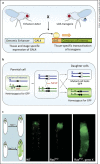Drosophila as a Potential Model for Ocular Tumors
- PMID: 27172095
- PMCID: PMC4847669
- DOI: 10.1159/000370155
Drosophila as a Potential Model for Ocular Tumors
Abstract
Drosophila has made many contributions to our understanding of cancer genes and mechanisms that have subsequently been validated in mammals. Despite anatomical differences between fly and human eyes, flies offer a tractable genetic model in which to dissect the functional importance of genetic lesions found to be affected in human ocular tumors. Here, we discuss different approaches for using Drosophila as a model for ocular cancer and how studies on ocular cancer genes in flies have begun to reveal potential strategies for therapeutic intervention. We also discuss recent developments in the use of Drosophila for drug discovery, which is coming to the fore as Drosophila models are becoming tailored to study tumor types found in the clinic.
Keywords: Cancer model; Drosophila; Ocular cancer; Ocular oncology; Retinoblastoma; Uveal melanoma.
Figures


Similar articles
-
Drosophila and the hallmarks of cancer.Adv Biochem Eng Biotechnol. 2013;135:79-110. doi: 10.1007/10_2013_190. Adv Biochem Eng Biotechnol. 2013. PMID: 23615878
-
Ocular oncology: advances in retinoblastoma, uveal melanoma and conjunctival melanoma.Br Med Bull. 2017 Jan 1;121(1):107-119. doi: 10.1093/bmb/ldw053. Br Med Bull. 2017. PMID: 28069617 Review.
-
Updates in imaging in ocular oncology.F1000Res. 2019 Oct 1;8:F1000 Faculty Rev-1706. doi: 10.12688/f1000research.19979.1. eCollection 2019. F1000Res. 2019. PMID: 31602297 Free PMC article. Review.
-
Recent advancements in the management of retinoblastoma and uveal melanoma.F1000Res. 2018 Apr 18;7:F1000 Faculty Rev-476. doi: 10.12688/f1000research.11941.1. eCollection 2018. F1000Res. 2018. PMID: 29755733 Free PMC article. Review.
-
Targeting tyrosine kinases for treatment of ocular tumors.Arch Pharm Res. 2019 Apr;42(4):305-318. doi: 10.1007/s12272-018-1094-3. Epub 2018 Nov 23. Arch Pharm Res. 2019. PMID: 30470974 Review.
Cited by
-
Modelling Cooperative Tumorigenesis in Drosophila.Biomed Res Int. 2018 Mar 6;2018:4258387. doi: 10.1155/2018/4258387. eCollection 2018. Biomed Res Int. 2018. PMID: 29693007 Free PMC article. Review.
-
Melanoma-Bearing Libechov Minipig (MeLiM): The Unique Swine Model of Hereditary Metastatic Melanoma.Genes (Basel). 2019 Nov 9;10(11):915. doi: 10.3390/genes10110915. Genes (Basel). 2019. PMID: 31717496 Free PMC article. Review.
-
The Drosophila functional Smad suppressing element fuss, a homologue of the human Skor genes, retains pro-oncogenic properties of the Ski/Sno family.PLoS One. 2022 Jan 14;17(1):e0262360. doi: 10.1371/journal.pone.0262360. eCollection 2022. PLoS One. 2022. PMID: 35030229 Free PMC article.
-
Salt inducible kinases as novel Notch interactors in the developing Drosophila retina.PLoS One. 2020 Jun 15;15(6):e0234744. doi: 10.1371/journal.pone.0234744. eCollection 2020. PLoS One. 2020. PMID: 32542037 Free PMC article.
-
Histone Deacetylases in Retinoblastoma.Int J Mol Sci. 2024 Jun 24;25(13):6910. doi: 10.3390/ijms25136910. Int J Mol Sci. 2024. PMID: 39000021 Free PMC article. Review.
References
-
- Matthews KA, Kaufman TC, Gelbart WM. Research resources for Drosophila: the expanding universe. Nat Rev Genet. 2005;6:179–193. - PubMed
-
- Venken KJ, Bellen HJ. Emerging technologies for gene manipulation in Drosophila melanogaster. Nat Rev Genet. 2005;6:167–178. - PubMed
-
- Hanahan D, Weinberg RA. The hallmarks of cancer. Cell. 2000;100:57–70. - PubMed
-
- Hanahan D, Weinberg RA. Hallmarks of cancer: the next generation. Cell. 2011;144:646–674. - PubMed
Publication types
LinkOut - more resources
Full Text Sources
Other Literature Sources
Molecular Biology Databases

